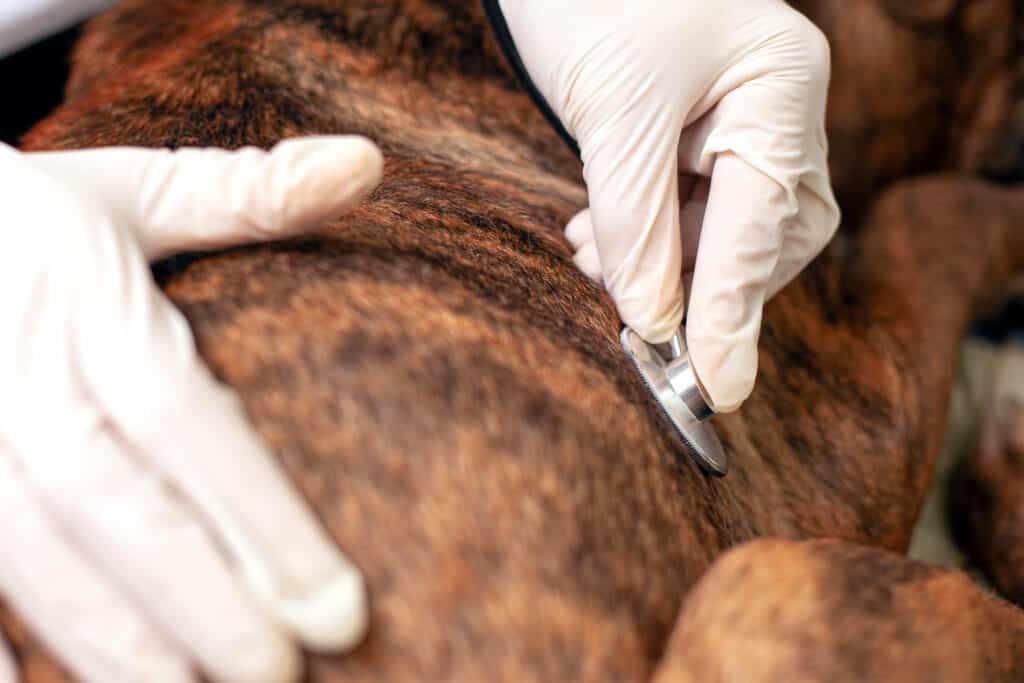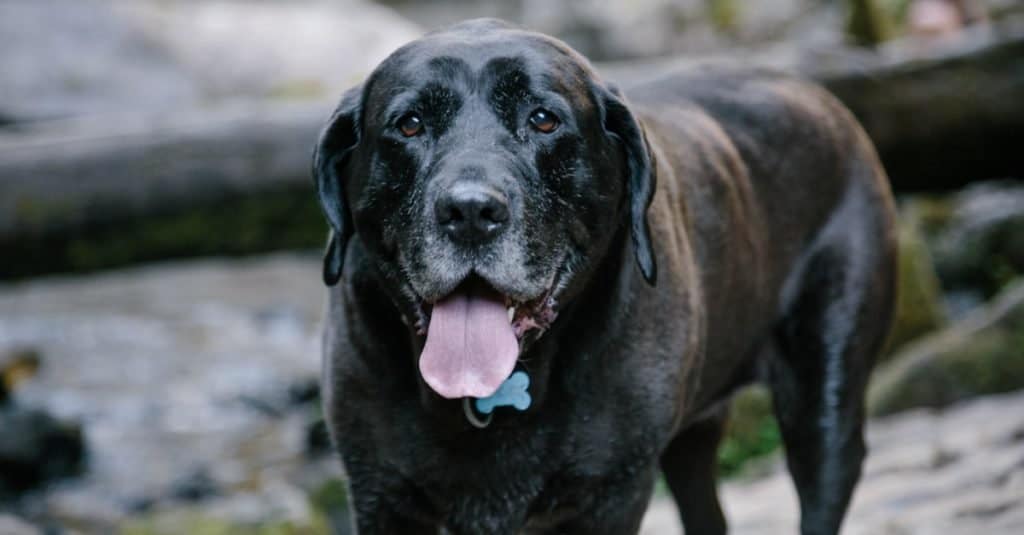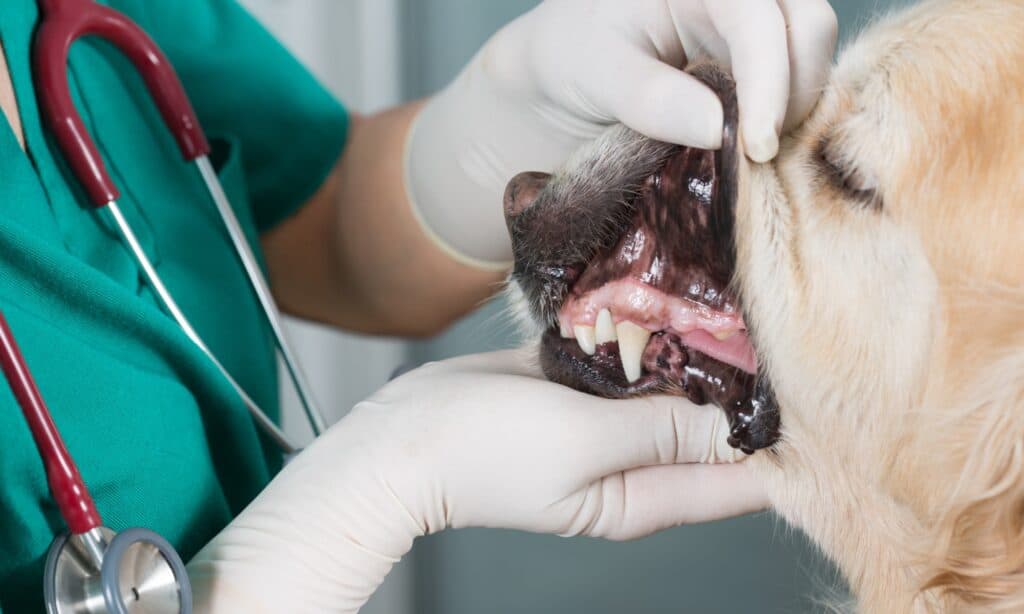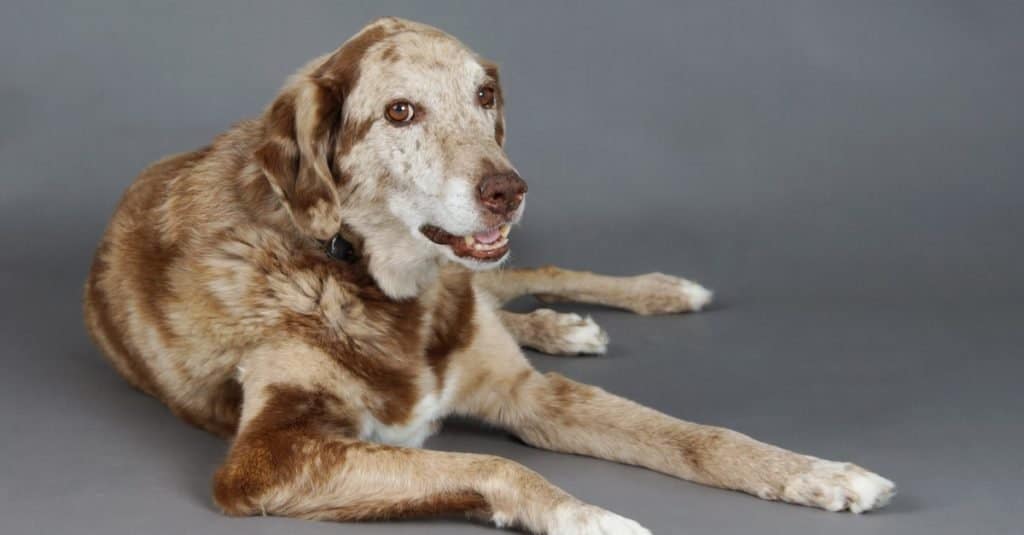Mastador
Canis lupus
The Mastador gets its enormous size from its Mastiff parent.
Advertisement
Mastador Scientific Classification
- Kingdom
- Animalia
- Phylum
- Chordata
- Class
- Mammalia
- Order
- Carnivora
- Family
- Canidae
- Genus
- Canis
- Scientific Name
- Canis lupus
Read our Complete Guide to Classification of Animals.
Mastador Conservation Status
Mastador Facts
- Fun Fact
- The Mastador gets its enormous size from its Mastiff parent.
- Temperament
- Friendly, active, and intelligent
- Diet
- Omnivore
Mastador as a Pet:
- General Health
- Energy Level
- Shedability
- Trainability
- Intelligence
- Tendency to Chew
- Size
- Family and kid friendliness
- Yappiness / Barking
- Moderate
- Separation Anxiety
- Moderate
- Preferred Temperature
- Average climate
- Exercise Needs
- High
- Friendly With Other Dogs
- Moderate
- Pure bred cost to own
- About $1,000 on average
- Dog group
- Non-sporting
- Male weight
- 105-160 lbs
- Female weight
- 85-140 lbs
This post may contain affiliate links to our partners like Chewy, Amazon, and others. Purchasing through these helps us further the A-Z Animals mission to educate about the world's species.
View all of the Mastador images!
The Mastador is often bred from one of the largest types of dogs in the world, the English Mastiff, which can easily reach 200 pounds.
The Mastador is a cross between a Mastiff (usually the English Mastiff) and a Labrador Retriever. Both types of purebred dogs are very popular in the United States. As a cross between two different breeds (the term for this is a designer dog), the Mastador may inherit a variety of different features from its parents. Most of the time, these dogs have an athletic build, a square muzzle (short or medium length), and slight wrinkles around the eyes. The double-layered coat is typically short and smooth, although sometimes a little wavy. The coat color can vary between black, brown, brindle, or yellow, sometimes mixed together in various patterns.
See all of our expert product reviews.

3 Pros and Cons of Owning a Mastador
| Pros! | Cons! |
|---|---|
| Good-natured The Mastador is sweet and affectionate. | Mischievous The Mastador’s playful behavior can sometimes become a little rambunctious and annoying. |
| Intelligent and Trainable The Mastador excels at following human commands and rules. | Requires Early Socialization Otherwise, this hybrid may become shy or aggressive, particularly around strangers. |
| Protective Due to its size and protective nature, the Mastador makes for a good guard dog. | Big Size The Mastador requires a lot of space, food, and attention. Its massive size also means some stressful physical activity could cause problems. |
Evolution and History
As with other hybrid dogs, there is limited information about the Mastador’s origins and history. It’s believed this breed was first introduced in the U.S. likely around the 1990s, when many designer dog breeds were being developed.
The Mastador’s parent breed the Mastiff is a massive dog with a wrinkled face that possibly has ancestors who were featured animals in ancient Roman gladiatorial arenas. They are thought to have been used as war dogs and for hunting game, with the modern-day breed established in the 1880s. Thanks to its protective nature and physical size, the Mastiff excels as a guard dog. Typically only the English Mastiff, and not other Mastiff variations such as Boerboels, Bordeaux, Bullmastiff, Cane Corso, or Neopolitan, is used for breeding the Mastador due to its less aggressive temperament and greater suitability as a companion.
The Labrador Retriever, the Mastador’s other parent breed, is a medium-sized breed that originated in Newfoundland around 1800s or even a few hundred years earlier to retrieve fish from the water that had fallen from fishermen’s hooks as well as pull in nets. It’s thought that the dogs were first seen in England in the 1830s on ships coming to trade goods from Canada. The English Kennel Club recognized Labradors as a breed by 1903. Labs gained more fans in the U.S. when the American Kennel Club did the same in 1917. The Labrador Retriever is now America’s most popular dog breed.

The Mastiff, one of the Mastador’s parent breeds, is known for its large size and wrinkled face.
©Christian Mueller/Shutterstock.com
Health and Entertainment for your Mastador
See all of our expert product reviews.
Size and Weight
The Mastador is a large dog with a big, muscular frame. Females will be slightly smaller than males on average.
| Height (Male) | 26 to 30 inches |
| Height (Female) | 24 to 28 inches |
| Weight (Male) | 105 to 160 pounds |
| Weight (Female) | 85 to 140 pounds |
Common Health Issues
As a designer dog, the Mastador has a chance to inherit some of the health problems from either purebred parent. These can include obesity, cataracts, pulmonary stenosis (a narrow or stiff pulmonary valve in the heart), hip or elbow dysplasia (which causes the joint to become temporarily dislocated), retinal dysplasia (folds, lesions, or even the outright detachment of the retina), and general bloating (which might not sound serious but can put significant pressure on the dog’s organs).
The Mastador is also prone to developing cancer, epilepsy, diabetes, and additional heart problems later in life. Unfortunately, since the odds of these conditions are a bit unpredictable, it is extra important that you choose a healthy dog from a good breeder whom you can trust. A healthy dog without any serious conditions stands a good chance of living between 10 and 15 years old.
To sum up some of the most common health problems:
- Obesity
- Cataracts
- Cancer
- Heart problems
- Bloating.

The Mastador is prone to developing heart problems later in life.
©fukume/Shutterstock.com
Temperament
The Mastador is a sweet, friendly dog that should integrate well into a family unit. Many people keep it as a guard dog since it does have the tendency to become very protective of its owner in the presence of unfamiliar people. The Mastador should ideally receive proper socialization from an early age to familiarize it with strangers. If it’s mishandled by its owner at all, then the dog can easily develop aggressive, fearful, or anti-social behavior as a full-grown adult.
Despite its large size, one of its more appealing traits is that the Mastador can do very well in indoor settings. However, it is never a good idea to keep this dog cooped up in small apartments for long periods of time, since it needs a large yard or open space to exercise and explore for at least part of the day. Another issue is that the Mastador does have the tendency to find its own entertainment if it’s ignored by its owner for long periods of time. This can result in some annoying or unwanted behavior. Make sure you are able to satisfy its desire for physical and mental stimulation before purchasing this dog.

The Mastador is a sweet and loyal breed that makes a great guard dog.
©Corrie Mick/Shutterstock.com
How to Take Care of the Mastador
Since it does require quite a bit of maintenance and care, the Mastador is best paired with an experienced owner who’s very attentive to both its emotional and physical needs. Once you decide that this hybrid is right for you, then the best places to obtain it are high-quality breeders and rescue shelters. There are unlikely to be many Mastador rescue groups, but you might be able to find one with a Labrador or Mastiff rescue organization that takes in mixes. Starting as a puppy, the dog should receive regular checkups at the vet to screen for potential health problems. If you need any special tips about its care, then you should consult with your vet as well.
The Best Dog Food for Mastadors
Depending on its size, age, and activity level, the Mastador may need as much as 3 cups of high-quality dog food every single day, preferably formulated for a large, energetic dog and divided into several meals to prevent bloating. This mix has a tendency to gain weight, so you should be extra careful about its calorie intake. It is never a good idea to overfeed your dog, even if it’s begging for food.
The Mastador is a lot of dog, and it obviously eats a lot of food. So owners need to put a lot of care into selecting the optimum dog food with adequate nutrition. Mastadors’ big hearts can unfortunately be likely to succumb to heart problems, so read up on legume-free dog food and the link between legumes and heart failure.
At A-Z Animals, we choose Diamond Naturals Light Dry Dog Food Lamb Meal and Rice Formula with Lean Protein from Real Lamb as the best dog food for Mastadors.
This legume-free recipe with lamb instead has taurine and L-carnitine for a healthier heart and clear eyes. It’s formulated to help maintain a healthy body weight, with 18% crude protein that satisfies the Mastador’s major appetite. Additionally, the probiotics ease digestion for this breed that can experience bloat.
Check Chewy and Amazon for this product.
- Made in the USA using quality ingredients from trusted domestic and global sources.
- Real pasture-raised lamb protein as the #1 ingredient, supports the needs of less active and overweight dogs.
- Omega fatty acids for skin and coat health
- Vitamins and minerals from superfoods, including fruits like blueberries and oranges.
- Includes probiotics, antioxidants and prebiotics to support healthy digestion, immune system health and overall wellness.
- No corn, wheat, artificial flavors or colors.
Maintenance and Grooming
Despite its tendency to shed, the Mastador’s short and stiff coat should stay clean naturally and does not require a lot of grooming or bathing. Weekly brushes should suffice to keep it clean. Other aspects of the dog’s maintenance will require more care, however. The Mastador will absolutely need regular ear cleanings to prevent infections. You should also brush its teeth a few times every week to reduce the chances of gum disease and bad breath.

Like most dogs, the Mastador needs regular dental care to reduce the chances of gum disease.
©iStock.com/fotoedu
Training
The Mastador is a quick and eager learner that takes well to human commands. Since it has a slight stubborn streak, this dog does best with a firm and strong leader who will take control and provide clear guidance. But owners should not be too aggressive, since this dog might respond poorly to overly harsh training methods. Ideally, puppies should receive early socialization and behavioral training between the ages of six and 18 weeks. This should hopefully break some of the bad behavioral tendencies that may develop as a full-grown adult.

The Mastador is a fast and eager learner.
©Corrie Mick/Shutterstock.com
Exercise
The Mastador is a very active mix that requires about an hour of exercise every day, preferably in the form of walks, fetch, playtime, or even swimming. But because of the enormous size, it may not do so well with high-impact or strenuous activities. This dog does have the ability to scale small fences, so if you want to leave it alone in your yard, then the fence should be at least 6 feet high. It also should not be left outside in very hot or cold weather for prolonged periods of time.

Mastadors need around an hour of exercise each day in the form of walks or even swimming.
©Corrie Mick/Shutterstock.com
Puppies
Potential owners should be very careful about where they buy their puppies. High-quality breeders are ideal since they tend to select only the healthiest parents to breed from. Low-quality breeders and puppy mills, on the other hand, might not have the well-being of the dog in mind. So it’s worth paying a little extra for the guarantee of better care. More than most types of dogs, Mastador puppies are full of energy and curiosity, so they need steady guidance during their socialization and training in order to prevent them from misbehaving and developing bad behavioral habits as a full-grown adult.

More than most dogs, Mastador puppies require steady guidance during their socialization and training.
©Laura S G/Shutterstock.com
Mastadors and Children
The Mastador is a good family dog that should develop loving, protective relationships with children. However, parents should be careful about introducing this dog into a home with younger children, since the dog’s enormous size could easily overwhelm them.
Dogs Similar to the Mastadors
The Mastador is obviously most closely related to its parent breeds, the Labrador Retriever and the Mastiff. It also bears several similarities to the following hybrids:
- Aussiedor – As a cross between a Labrador Retriever and an Australian Shepherd, the Aussidor is a medium-sized dog with a real motor. This makes it a very good companion for owners who love to exercise and play. Another appealing trait is a large number of coat colors and patterns that can arise, including a sort of brindle pattern.
- Borador – This mixture between a Labrador Retriever and a Border Collie is high on energy and sweetness. Its intelligence, athleticism, and affectionate nature should endear it to owners who are seeking a close canine companion. It tends to have a black-and-white color.
- Spanador – This is a cross between the two most popular breeds in the United States: the Labrador Retriever and the Cocker Spaniel. Like its parents, this dog is intelligent, sweet-natured, and very lovable.

The Aussidor, another hybrid crossed with a Labrador, sometimes has a brindle-patterned coat.
©Sylvie Bouchard/Shutterstock.com
Famous Mastadors
Perhaps the most famous Mastador of all time was a dog named Spike. Rescued from a shelter as a puppy, Spike went on to play the title character in the popular 1957 film “Old Yeller,” which is about a boy and his dog growing up in Texas after the Civil War. Spike also appeared in “The Micky Mouse Club,” “Lassie,” “The Westerner,” “The Silent Call,” “The She-Creature,” and “A Dog of Flanders” before passing away in 1962. His owner was actor and dog trainer Frank Weatherwax.
Popular Names for the Mastador
If you need some help naming your dog, then you might want to consider the following options:
- Bella
- Charlie
- Luna
- Lucy
- Duke
- Zeus
- Cooper
- Max
- Moose
- Beau
Mastador FAQs (Frequently Asked Questions)
What is a Mastador?
The Mastador is a cross between a Labrador Retriever and a Mastiff. These are generally big, athletic dogs with short fur and a friendly, loyal personality. They make good guard dogs and fun-loving companions. The coat colors are usually black, brindle, brown, or yellow.
How do you train a Mastador?
The Mastador should respond best to positive reinforcement methods involving praise, treats, or other rewards. It also responds well to a firm and strong leader. If it’s being a little stubborn, you should never raise your voice or react aggressively toward this dog. This might just cause it to resist its training. If you need help, then there’s no reason you can’t take your dog to a private trainer.
Are Mastadors dangerous?
Mastadors are very sweet, good-natured dogs. They will only be aggressive when mishandled or poorly socialized as a puppy.
What is the price of a Mastador puppy?
As a rarer designer dog, the Mastador will cost an average of around $1,000, although the price might be considerably more or less depending on the dog’s pedigree and the quality and reputation of the breeder. The price of food and care will also be quite a lot higher than an average dog.
Are Mastadors easy to train?
Yes, Mastadors are quick learners and want nothing more than to please its owner.
Thank you for reading! Have some feedback for us? Contact the AZ Animals editorial team.
Sources
- Pet Guide, Available here: https://www.petguide.com/breeds/dog/mastador/
- Wag Walking, Available here: https://wagwalking.com/breed/mastador
- K9 Of Mine, Available here: https://www.k9ofmine.com/labrador-mixed-breeds/


















